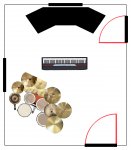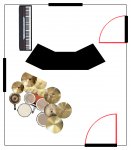I'm looking for some advice on how I should layout my meager "studio" room. I have a spare bedroom that I use for my recording. The room is 11'4" by 13'2". I only do recording for myself, and record drums, keyboard, and bass guitar for my personal projects. There are 3 main components I need to be able to fit into the room in any sort of reasonable fashion: the drum kit, the keyboard, and the desk (which houses my computer, monitors, & various tools. I have attached 2 layouts below I'm thinking of, and would love some advice on what is going to be the most conducive to quality recording (in terms of sound wave direction, etc). All items in picture are drawn to scale.
Thanks!
Thanks!



